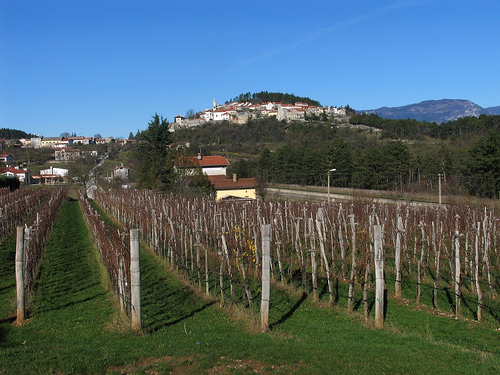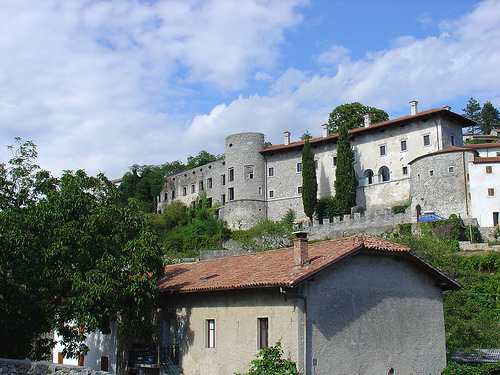

Location: Littoral Region Map
Tel. 00386 5 769 0197

Štanjel is a historic fortified settlement in Littoral region in South West Slovenia. First village in the area of modern day Štanjel was found here by the Ancient Romans. Roman artefacts were discovered during archaeological digs here. Although there have been evidence of much earlier human presence from the Iron Age. In the 11th and 12th century the village was fortified. Military fortifications were further increased in the late 17th century by the Count of Cobenzi as a response to a possible threat from the invasion of the Ottoman Turkish from the South East. Medieval structures were badly damaged during World War II, but it was subsequently remodelled after the war.
Due to its traffic-geographical and strategic
viewpoint, Štanjel has been important since the early Iron Age . The
settlement experienced its greatest boom in the Romanesque period as
it spread across the forest towards the top of Turn. In the 11th to
12th centuries the hill was newly fortified - today the remains of
the tower at the top of Turn are still visible.
There are many Gothic elements that prove that the settlement
reached its present size in the Middle Ages. The oldest remains of
the castle date back to the Middle Ages , with Renaissance defense
towers built. It was given a new look by the counts of Cobenzli at
the end of the 17th century. The burned castle, only the perimeter
walls were preserved, was renovated after the Second World War
according to the plans of architect Natasa Suhadolc Šumi. A
collection of works by Karst painter Lojze Spacal has been arranged
in the renovated half of the castle. It was later supplemented by a
collection of local history. They have concerts and weddings in the
castle hall. Due to the risk of Turkish invasions , Štanjel was
protected by walls at the end of the 15th century. There is a
restaurant on the ground floor of the castle.
A special seal place gave Fabiani Trieste friends and family
physician Enrico Ferrari . Ferrari fell in love with Stanjel. He
spoke good Slovenian and spent several months here every summer. He
also regularly came to Štanjel for all other days off. In 1924, he
and Fabiani began ambitious work that lasted until 1942. During this
time, they set up a large park under the defensive wall on the south
side of the village . Ferrari had a permanent manager employed.
Twenty or more workers were occasionally employed in the
construction of the park. The stones used for construction were
driven from the quarry near the settlement Tupelče. Ferrari bought
seven houses in Stanjel and almost all the vacant land around the
village all the way to Podlasov so that it could walk a little half
an hour on its property in the direction of Gornja Branica. Fabiani
also helped refurbish the castle and many houses in the villages and
in the nearby Kobdil during the wars.
It is a well-known story that just before the end of the war, the
German army wanted to demolish the castle of Stanjel , which was
prevented by the architect Maks Fabiani by intervention. He was
referring to Hitler's science from the period when he wanted to
become a painter in Vienna. The commanding officer may have called
to Berlin and may have received an answer "to please the old man in
disgust." The story is more than just a legend, since Fabiani's
science with Hitler was probably only a fleeting one, though he
wanted to study architecture in Vienna. After World War II, the
settlement was very slowly repaired. Many locals moved out because
the village was without water supply until 2015. Now old and many
new settlers are renovating individual houses. Along with typical
Karst motifs, fountains and paws, memorial portrait heads of Taras
Shevchenko, Joseph Abram and Anton Mahnic are on the church and in
the street next to the Karst House. A missing monument to Max
Fabiani is also missing.
Štanjel Castle (Italian San Angelo) is located in Štanjel in the municipality of Komen. The Štanjel area was settled and fortified already in the Hallstat and later under Roman occupation. In the 11th to 12th centuries the hill was newly fortified - today the remains of the tower at the top of the Turn can be seen. In 1470 and 1481, Štanjel was looted by the Turks. In 1580 it was occupied for a short time by the Venetians. In 1848 it was conquered by rebellious oppressors. During the First World War, the interior of the Austro-Hungarian soldiers devastated the interior. In 1944, Kosovel's brigade clashed with the Germans in the castle and the castle was then demolished.